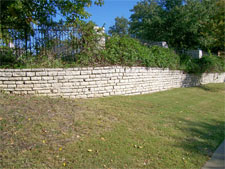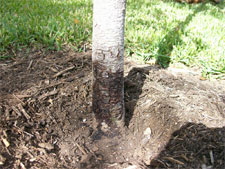Question and Answer – December 2008


Question: We want to replace 20-year-old, very invasive honeysuckle vines that are planted in a row between our wrought iron fence at the edge of our property and a rock retaining wall with dwarf burford hollies. We plan to space the bushes on 4-foot centers to create a privacy hedge. What is the best and quickest way to kill the honeysuckle and then safely replant with the hollies? We intend to dig or pull the honeysuckle roots after killing it. Note that we have a vegetable garden just inside of the fence adjacent to the honeysuckle vines. B.M., McKinney.
Answer: Hand-digging is probably your best option, although it would be a lot of work. Do so after a rain, while the soil is still wet and while the roots will be easily extricated. Honeysuckle can easily be killed with a broadleafed weedkiller containing 2,4-D. However, those sprays are ultimately damaging to many vegetables, so much so that they should not be used anywhere near existing plantings. April or May would be the best time to treat the vine. Give the herbicide 15 to 30 days to do its work, then grub out the worst of it. The rest should present little additional problem. However, you may have a few seedlings that will show up subsequently. They can easily be removed by cultivation. Consider 42-inch spacings on the dwarf burfords if you want a solid growth.


Question: We sodded our yard in May 2007 with Reveille hybrid bluegrass developed by Texas A&M. It did well until a few months ago when these brown spots started to appear (not dog-related). They resemble brown patch, but the descriptions do not sound like that is the diagnosis. We’re wondering about chinch bugs. Now, the brown patches are dead and bare, and it looks like we’re going to lose our yard. Do you have any suggestions? (You’ll also notice that bermuda is invading the grass in one area, but my husband has found a treatment to control it pretty well.) G.B., Plano.
Answer: Reveille hybrid bluegrass isn’t that common as a turfgrass in Texas lawns yet, so I really haven’t had as much first-hand experience with it as I might like. However, this looks like the same kind of brown patch (Rhizoctonia) outbreak that I saw on fescue in my own lawn over a several-year period back in the early 1990s. Fungicides didn’t help very much. The grass died away before I could save it. Bunch grasses (clump-forming, as opposed to runner-producing) tend to be hurt more by brown patch, since it kills the entire plant. There are no runners to produce new blades. With St. Augustine, only the blades are affected. The runners remain alive and capable of producing new leaves when conditions improve. I finally told the people who wanted me to endorse fescue as a turfgrass that I couldn’t tolerate that type of annual disease issue with it, and we parted company. However, as I ramble back to my original thought, I am not intensely familiar with the day-to-day of maintaining Reveille, so I asked the advice of my go-to plant pathologist Dr. Phil Colbaugh, retired from the Texas A&M system. Phil confirms that this does, indeed, look like brown patch, and that he is aware of a history of this disease with this grass. Water only in morning hours, as brown patch is accelerated in cool, moist nighttime conditions. Should it still show up, labeled turf fungicides are about the only option.

Question: I start lots of cuttings in a well-respected brand of potting soil. Recently, a mold has formed on the tops of the pots and some down inside the pots. Is it harmful, and what should I do to control it? E., Arlington.
Answer: This is a saprophytic fungus (lives off decaying organic matter, not off living plant tissues). As such, the only threat it would pose would be if it grew up and over your cuttings. Also, some of these types of fungal growths can form a rubbery mat on the top of soil, especially on moist, highly organic mixes. You could carefully apply a fungicide or dusting sulfur, but don’t get the latter on tender new foliage of recently rooted cuttings. I’ve used an old table fork to remove this type of growth mechanically. You might also try letting the plants stay ever so slightly drier to discourage its growth.

Question: I’m in the commercial landscaping business, and a crew leader called with an issue on dwarf yaupon hollies. When I got to the site, they were almost totally defoliated by what appears to be Texas asps. Have you ever seen them this thick? There are eight plants, and they were completely covered. T.S., Dallas.
Answer: Wow! And, you’re right on your identification. They’re also commonly called puss caterpillars, and they’re the larval form of an unremarkable moth. As you and your crew were probably already aware, the stings they can inflict from the ridge of hairs down their backs are extremely painful. General-purpose insecticides (including "B.t." biological worm spray) will eliminate them. This sort of population concentration is quite unusual. They hit a standard yaupon of mine profusely many years ago, yet they’ve never been back. I’m sure your crew will push the dwarf yaupons to grow vigorously next spring with applications of nitrogen. It might help to shear them somewhat between now and the end of winter.

Question: I have enclosed pictures of a Shumard red oak tree that was planted a year ago. There is sap oozing from the base of the trunk and two small areas of a frothy, foamy substance. I suspect insect damage. Can you advise as to how to proceed in correcting this problem? B.R., Austin.
Answer: This is sunscald. It’s extremely common when we plant new red oaks, chinquapin oaks and Chinese pistachios and then don’t protect their trunks with paper tree wrap from the nursery or hardware store. Trees that formerly shaded one another are suddenly exposed to bright sunlight. Like a windshield cracks and splits when temperatures change quickly on cold, sunny mornings, so does the wood of the trunk. The oozing is coming from sap flow that has developed from broken conducting tissues. The blackening is sooty mold that grows in the sugary sap. About all you can do now is to clean away any active decay and leave the trunk to heal on its own. You can apply a borer preventive insecticidal spray during the next growing season, but borers that are already in the trunk will be difficult to kill. They tend to show up after sunscald has done its damage. You might protect it with the tree wrap, but you’ll want to open it up every couple of weeks to check on how things are looking. Good luck. This is a serious problem, and it’s the reason the wrapping is non-negotiable with these trees.

Question: We have an 8-year-old avocado tree that we’ve grown from seed. It got too big to move in and out, so we planted it in the yard. How do we protect it, or can we? B.M., no city given.
Answer: If you live anywhere north of the Lower Rio Grande Valley, it will be essentially impossible to pull it through the winter. Avocados cannot withstand sub-freezing temperatures. Your only option would be to construct a temporary winter greenhouse over it. You’d have to have some source of heat on the coldest nights, again depending on where you are.

Question: Should I be concerned about the little yellow spots that have appeared on the leaves of my volunteer cottonwood tree? Should I treat it? K.B., Burleson.
Answer: You can’t justify treating any leaf condition on a deciduous tree this late in the season. Those leaves are, or soon will be, on the ground for this season. Odds are, you’ll never see this organism show up again. If you’re sure you want a volunteer cottonwood (it may start producing cotton any spring), this outbreak won’t hurt it. It will take off at a fast pace next spring.

Question: I have redtip photinias that are 20 years old flanking my door. They are unhealthy looking in spite of a long-term organic program, and they make the house look like a Hobbit abode with a tiny entry. What could I use to replace them? It’s very shady. J.H., no city given.
Answer: You need to use one of the several dwarf hollies. Carissa and dwarf burford hollies would be your best choices. They can handle sun or shade, and they’re much more compact and refined than redtips. The photinias, just for the record, grow to 18 to 20 feet tall. It’s not practical to keep them much below 8 or 9 feet, plus they are riddled with a fungal leaf spot for which we have no good control. The hollies will move you past all of that.

Question: What is this growth on my live oak? Do I need to do anything about it? S., Valley Mills.
Answer: As with the potting soil question above, this is a saprophytic fungus. It’s not actually invading the living tissue of the live oak, but it does suggest that there is active decay in the stub where a limb was removed. Probably your best bet would be to hire a skilled arborist to help you with the tree. He or she will recognize if there is a major issue, and if so, what the best remedies would be.

And, along a similar line…
Question: This is a huge cluster of live oak trees that is the focal point of our entire back yard. We have had several large live limbs just break off, and we are concerned that something is terribly wrong with our trees. Can you please tell me what this is and what to do for it? J.M., no city given.
Answer: While there is what is probably a similar saprophytic fungus involved here, it definitely appears that your trees have a more serious issue that is causing the bark to crack and split away. I can’t tell from the photographs alone. You need to have a certified arborist who is skilled in oak issues inspect your trees immediately.

Question: This vine is encroaching on several branches of a hackberry tree, some of which extend over my yard. Is it anything to be concerned about? It would be a challenge to cut or dig it out at its source, as the tree has its roots on a steep slope of a creekbed. D.D., Richardson.
Answer: This is Virginia creeper (Parthenocissus quinquefolia). It’s a native vine that will ascend tree trunks and branches, but it’s not terribly aggressive. If it becomes distracting, all you would really have to do is sever its stem at the point at which it comes out of the ground. Winter is a good time to do so, so you won’t have dead foliage hanging on its branches. However, if you like the look it gives, leave it alone. As your photo shows, it gives nice fall color.

Question: This photo shows a crape myrtle we planted during the summer. We have noticed a white substance on the flower buds (see photo). It began looking bad soon after it was planted. What can the problem be? M.P., Frisco.
Answer: The photo you sent seems to be of the late-season seed heads rather than flower buds. However, powdery mildew is what you probably saw. It’s a fungal disease that has bothered old-fashioned crape myrtles for all of their existence in southern gardens. New varieties, particularly those from the National Arboretum (named after Native American Indian tribes) are much more resistant. We have considerable information on the website www.crapemyrtletrails.org. You’ll find cultural and varietal information as well as guidelines on dealing with the disease.

